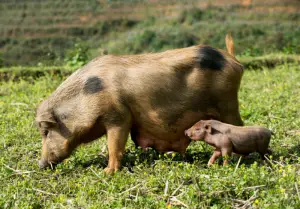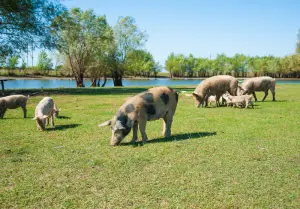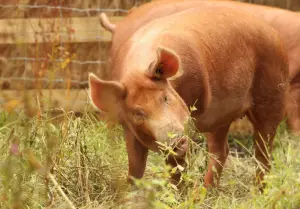Pig Maturity Age For Breeding And Slaughter Guide
Every successful pig farming operation must keep a strict timeline for the life cycle of its hogs. There is a time to wean, a time to breed, and a time to process. Fortunately, because pig farming is such a significant industry worldwide, there has been much research into the optimal timing of breeding, slaughter, and other pig-related milestones.
What is the optimal age for pig breeding? On average, immature females (gilts) reach sexual maturity between 5 and 6 months of age, but should wait until their 2nd or 3rd cycle to be bred. Boars can begin being used for breeding between 7 and 8 months of age, and are considered mature and able to be used regularly by 12 months of age.
What is the optimal age for pigs to be slaughtered? Slaughtering is typically done when a pig reaches between 250 and 300 pounds. What age a pig will reach market weight will depend on the breed, but most market hogs are ready to be slaughtered and processed by around 6 months of age.
Read on for more information on how to know when your pig is ready for breeding, and when your pig is ready to be processed.
Optimal Age For Pig Breeding
The ideal age to breed your pig will vary depending on the gender of the animal. The optimal age for a gilt’s first breeding is going to differ from the optimal age to start a boar. There is extensive data surrounding the breeding of pigs, with no shortage of recommendations.
Pig Breeding Age For Gilts 
A gilt is a female pig who has not yet been bred. The age at which a gilt will go into estrus for the first time (reaching sexual maturity) will vary slightly by breed. Most commercial pig breeds reach sexual maturity between 5 and 6 months of age. The Landrace and the Yorkshire typically mature earlier than other breeds like the Duroc and Hampshire. Meishans reach sexual maturity at an exceptionally young age – having their first cycle by around 3 months of age.
Researchers (as well as practicing farmers) have discovered that a breeding program will be much more successful if a gilt is bred for the first time during her second or third heat, putting the ideal age to breed gilts between 7 and 8 months. There are multiple benefits to waiting until the second or third estrus, including:
- Increased litter size – Gilts bred for the first time during their third cycle have been shown to produce 1-2 more piglets than gilts bred for the first time during their first cycle. The first heat of a gilt will include the fewest number of eggs. The numbers will increase during the 2nd cycle, and will increase further during the 3rd cycle.
- Increased success rate – Again looking at third estrus vs. first estrus research, gilts have been shown to have a 77.4% chance of a successful breeding during the third cycle, as opposed to a 69.6% chance of success during the first cycle. While it could be possible that the 4th heat may have an even higher percentage, little research has been done on waiting until after the 3rd heat because this simply is not economical for most operations.
- Increased breeding longevity – Gilts started during their second estrus (or third) seem to stay in the breeding program for a longer period of time than those started during their first estrus. Breeding during the first cycle seems to have a lasting negative impact on future pregnancies.
Another benefit to waiting until the 2nd or 3rd heat is a later farrowing (birthing) age. Assuming the average first heat of 5-6 months and waiting 2 cycles before breeding puts the farrowing age at 10-12 months; an ideal age for a first litter. A (slightly) older first-time mother is more likely to have the level of maturity required to raise offspring.
Pig Breeding Age For Boars
While one might assume that sows are more valuable to the breeding program than boars (understandably), you might be surprised by the impact that the boar can have. Boars have more genetic impact on the offspring than do the sows, and a breeding boar should be chosen carefully and wisely.
The way that a boar is started will either make him a confident and successful breeder, or will cause him to be intimidated and ultimately fail. Boars should be started gradually and the first breeding attempt should be with a small, docile sow or a gilt who is clearly in estrus. It is important that the first breeding be successful, to allow the boar to gain confidence. The more enjoyable he finds the process, the more likely he will be successful in the long run.
A boar can be started on a limited basis when he is between 6 and 7 months of age. Use him sparingly for a month or so, and then he can be increased to 2-4 services per week until he is a year old. Once he is mature (at one year of age), he can be used regularly for 6-10 services per week.
Optimal Age For Pig Slaughter 
The ideal time to process or slaughter a pig will depend on the weight more so than the age. Some breeds of pig mature more slowly than others, and may not reach an optimal market weight until 6-12 months later than the typical commercial breed.
Most pigs are slaughtered between 250 and 300 pounds, which many breeds reach by the time they are 6 months of age. For reference, here are a few popular breeds along with their average age at slaughter:
- Berkshire – 6 months
- Duroc – 6 months
- Tamworth – 6 months
- Hampshire – 7 months
- Yorkshire – 7 months
- Large Black – 15 months
- Kunekune – 15 months
- Mangalitsa – 18+ months
As you will notice, there is a wide range of ages at which a pig will reach market weight. Most of the large pork producers will use breeds that mature quickly, like the Yorkshire, Berkshire, and the Duroc. These are three of the most popular pigs for pork production in the United States.
Other breeds will take a much longer time to mature. The slower-growing breeds are typically ones that are best suited for pasture-raising. The Large Black, for example, is an excellent forager that can thrive and grow with a large percentage of its diet being pasture and forage.
Many of the commercially-used breeds are better suited to being raised in confinement. Pasture-raised pork is highly desirable as many argue that it is much more flavorful and tender. Mangalitsas in particular are known for their exceptionally high quality of meat – often called the “Kobe beef of pork” – and are considered to be well worth the wait.
Pig Diet Will Affect Slaughter Age
In addition to breed, the diet a pig is fed will affect the age at which market weight is achieved. When a person expresses a desire to lose weight, most nutritionists and doctors will give the following advice: “eat less, exercise more, and eat more fiber”.
The same is true for pigs. Pigs who are fed a high-fiber diet will grow more slowly – in fact, many pig farmers added additional fiber to their pig’s diets during the closure of many meat processing plants during the COVID-19 pandemic. There simply were not enough processors to handle the number of pigs that were approaching market weight, and farmers needed to slow the growth of their herds.
Naturally, a pig that is out foraging for a large part of the day will gain weight more slowly than a pig who lives entirely in confinement. Pigs on pasture will burn more calories than pigs that are living on concrete in pens, and will add weight more slowly.
And of course, pigs who eat less will gain weight more slowly. Most pork producers “free-feed” their pigs, allowing the hogs to self-regulate the amount of feed they take in. This is the ideal way to feed pigs, as opposed to limiting feeding to twice daily.
In addition to the above, it has been discovered that vitamins can play a role in growth rates. Of course, a pig who is not receiving adequate nutrition will experience poor growth rate. But in addition to feeding hog-specific pre-formulated feeds, it has been found that adding an additional supplement of Vitamin C (approximately 400 grams per pound of feed) will lead to faster growth rate and thus, earlier processing.
Understanding Your Pig’s Life Cycle
Before you take on the task of starting your hog operation, it is important to understand your herd’s life cycle. Knowing the ideal time to process your hog will ensure that you are getting the most meat for the least amount of expense.
And if you are breeding your pigs, waiting until the optimal age will bring greater success in both litter size and breeding longevity. Being a mindful steward of your herd will lead to both healthier and happier pigs and a greater profit.

